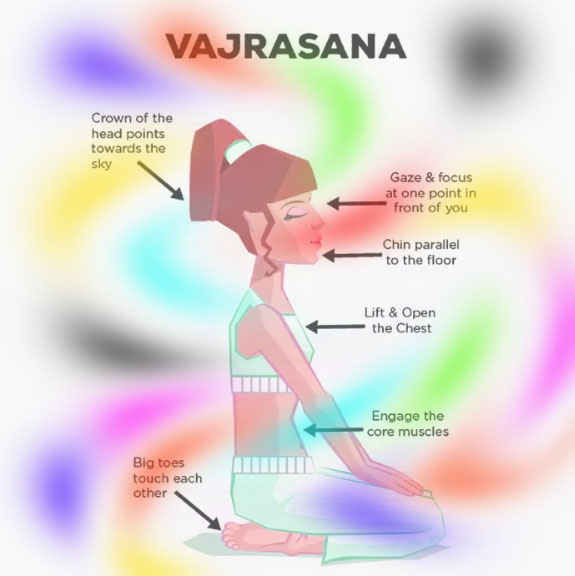How To Do The Vajrasana And What Are Its Benefits

Sanskrit: वज्रासन; Vajra – Diamond or Thunderbolt, Asana – Pose; Pronounced as vahj-RAH-sah-na
Vajrasana is a kneeling pose, and it takes its name from the Sanskrit word Vajra (वज्), which means diamond or thunderbolt. Asana (आसन), of course, means pose. This diamond pose is also called Adamintine Pose. You can attempt some Pranayam while sitting in this position.
Everything You Need To Know About The Vajrasana
- What You Should Know Before You Do The Asana
- How To Do The Vajrasana
- Precautions And Contraindications
- Beginner’s Tips
- Advanced Pose Alterations
- Benefits Of Vajrasana
- The Science Behind Vajrasana
- Preparatory Poses
- Follow-Up Poses
What You Should Know Before You Do The Asana
Yoga is supposed to be practiced on an empty stomach, but this asana is one of the few exceptions. You can safely perform this asana after a meal. In fact, it is more effective if performed immediately after a meal. This pose promotes proper digestion.

- Level: Beginners
- Style: Hatha
- Duration: 5 to 10 Minutes
- Repetition: None
- Stretches: Ankles, Thighs, Knees, Hips
- Strengthens: Legs, Back
How To Do The Vajrasana
Kneel down, stretching your lower legs backward and keeping them together. Your big toes and heels should be as closely held as possible. People with stiff ankles can support the joint by rolling a towel underneath to support the ankle arch.
Gently lower your body such that your buttocks are resting on your heels and your thighs on your calf muscles.
Place your hands on your knees, and set your gaze forward with your head absolutely straight.
Turn your attention to your breathing. Be fully aware of how you breathe and carefully observe as you inhale and exhale.
You could close your eyes to concentrate on your breathing and to calm your mind.
Try to stay in this position for a minimum of 5 to 10 minutes.
Precautions And Contraindications
This asana is extremely safe. However, these are a few things you should be cautious about when you start practicing this asana.
It is best to avoid this asana if you have a knee problem or have undergone surgery in your knees recently.
Pregnant women should keep their knees slightly apart when they practice this asana so that they avoid putting pressure on their abdomen.
Try not to over arch or overuse your lumbar spine to sit erect.
Those suffering from intestinal ulcers, hernia, or any other problems related to the large or small intestine should practice this pose under the guidance of a yoga instructor.
Beginner’s Tips
As a beginner, when you assume this position, it is likely that your legs might begin to pain in no time. If this happens, all you need to do is undo the asana, and stretch your legs forward. Give your ankles, knees, and calf muscles a good massage. In time, with practice, you should be able to go up to 30 minutes comfortably in this asana.
Also, beginners should work slowly and gradually on bettering the strength of the muscles in the lower back before they try to go deeper into the pose or increasing the duration. Once the lower back is strengthened, the strain on the breath is decreased. It is also important to note that if you push yourself more than your body can take, the benefits of the pose are minimized.
Advanced Pose Alterations
The advanced variation of the Vajrasana is the Supta Vajrasana. In this variation, once you sit in Vajrasana, you need to bend backward and place both your forearms as well as elbows on the floor. Then, arch your dorsal spine and neck until the base of your head touches and rests on the floor or is supported with a thin pillow. This asana helps strengthen the muscles in the neck, back, and chest regions. It also expands the chest and relieves lung problems. However, it is important to master the Vajrasana before you try this pose. It is also best to practice the Supta Vajrasana under the guidance of a yoga instructor.
Benefits Of Vajrasana
These are a few amazing benefits of the Vajrasana.
This asana improves digestion and with regular practice, it eliminates constipation.
Better digestion prevents ulcers and acidity.
This asana strengthens the back and relieves patients suffering from lower back problems and sciatica.
This asana strengthens the pelvic muscles too.
It helps to ease out labor pains and also reduces menstrual cramps.
This asana is one of the best ones to assume when you wish to go into a meditative state since it is an upright pose.
The Science Behind Vajrasana
The Vajrasana is a steady, firm pose, and those who assume it cannot be shaken easily. It is a meditative pose, but sitting in this pose can be quite challenging. One has to conquer the pain in the legs and the unrest in the mind to master the pose and enter a meditative state. One needs to train themselves to sit still and be willing to invest their mind in it.
The Vajrasana regulates blood circulation in the lower pelvic region. Sitting on your legs reduces the blood flow in the legs and increases it in the digestive area, therefore increasing the efficiency of the digestive system.
Preparatory Poses
Ardha Shalabhasana
Shalabhasana
Follow-Up Poses
Makarasana
Balasana
Shavasana





